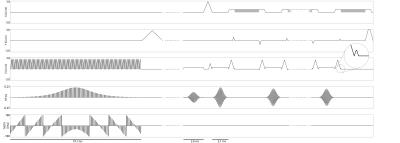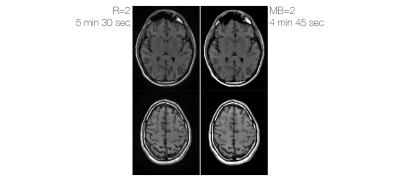1487
Inversion Recovery with SMS PROPELLER1Neuroradiology, Karolinska University Hospital, Stockholm, Sweden, 2Clinical Neuroscience, Karolinska Institutet, Stockholm, Sweden
Synopsis
We show that simultaneous multi-slice (SMS) PROPELLER can be used with inversion recovery. This is accomplished by using an adiabatic multi-band RF pulse (PINS-DANTE), an in-house developed PROPELLER sequence and a reconstruction that calibrates both in-plane-GRAPPA and slice-GRAPPA weights for all PROPELLER blade angles on a single fully sampled PROPELLER blade volume.
Purpose & Background:
We previously suggested a method [1] to acquire and reconstruct PROPELLER [2] scans accelerated with simultaneous multi-slice (SMS) [3]. The basics of the method is to perform slice-GRAPPA [4] and regular in-plane-GRAPPA [5] calibration on the first propeller blade volume. The scan then comprises of only one blade volume being fully sampled in both the phase encoding direction and slice direction, and with the remaining blades fully accelerated without any ACS lines. In this work we combine our SMS PROPELLER technique with the adiabatic PINS-DANTE [6] pulse to achieve inversion recovery (IR) contrasts.Methods:
An in-house developed PROPELLER sequence with support for IR and fast spin echo readouts was modified to also support multi-band (MB) RF pulses and blipped-CAIPIRINHA [7]. A PINS-DANTE pulse based on a hyperbolic-secant (HS) [8] pulse was used as inversion pulse. The HS-pulse was created with parameters: B1max= 23.5 Gauss, 𝛃 = 500 radians/s, 𝛍 = 5. RF pulses used for excitation and refocusing were regular MB-pulses, based on the vendor’s RARE [9] pulses, with optimized phases [10]. The peak power was managed by automatically stretching the RF pulses to meet an acceptable peak value. All RF calculations and pulse generation were implemented within the PSD. An overview of the PSD is shown in Figure 1. The reconstruction chain described in [1], and also illustrated in Figure 2, was used. Where the slice-GRAPPA calibration volume is a separate fully sampled blade volume with single band RF pulses with the same bandwidths as their multiplexed counterparts.
To demonstrate the capability of the IR SMS PROPELLER sequence, we acquired T1-FLAIR images with and MB-factor of 2, reconstructed using cross-calibration GRAPPA [11], and compared it to a similar scan without MB-factor but with an in-plane acceleration of 2. Common scan parameters were as follows: FOV = 240×240 mm2, matrix = 320×40, slice thickness = 2 mm, Nslices = 80, exc./ref. FA = 90°/160° and RBW = ±50 kHz/FOV. In-plane accelerated scan parameters: R = 2, TE/TR = 40/2700 ms, ETL = 10, Nacq = 4 and a scan duration of 5 min 30 sec. SMS accelerated scan parameters: MB = 2, TE/TR = 36/1800 ms, ETL = 8, Nacq = 2 and a scan duration of 4 min 45 sec. The scans were performed on a 3T MRI system (DVMR750w, GE Healthcare, Milwaukee, WI) system using a 32-channel RF head coil (Nova Medical, MA, USA).
Results & Discussion:
The resulting images, presented in Figure 3, are reconstructed without artifacts. The noise is marginally more noticeable in the SMS accelerated image, but it is almost one minute faster than the in-plane accelerated scan.
Our work shows that PROPELLER scans with IR contrast can be accelerated with SMS, allowing scan time reduction and increased scan coverage, while retaining the flow-artifact reduction and motion correction capabilities of the original PROPELLER.
The PINS-DANTE pulse is longer than the single band adiabatic IR pulse, but this does not have a large impact on the scan time since it is still much shorter than the FSE train duration.
Going to higher in-plane acceleration factors than two with PROPELLER is difficult for cross-calibration GRAPPA since the GRAPPA kernel points come too far from each other to proper predict the missing lines. Using acs lines with a narrow propeller blade as an alternative would hinder the net acceleration. SMS acceleration on the other hand does not have the same problem, which could enable even higher accelerations depending on the number of receiver channels, and does not reduce the amount of data as does in-plane acceleration.
SMS acceleration can lead to a shorter scan time with similar image quality if the number of acquisitions can be reduced, or if the TR can be reduced without a corresponding reduction in SNR due to limited T1 relaxation. This is one of the reasons for choosing T1-weighted FLAIR as an application since it usually requires several acquisitions to obtain many slices keeping a TR below about 2-3 s.
Acknowledgements
No acknowledgement found.References
1. Norbeck O, Mårtensson M, Avventi E, Engström M, Skare S. Self-Calibrated Simultaneous Multi-Slice PROPELLER. ISMRM 23rd Annual Meeting & Exhibition. 2015 Proceedings of International Society for Magnetic Resonance in Medicine; 2015.
2. Pipe JG. Motion Correction With PROPELLER MRI: Application to Head Motion and Free-Breathing Cardiac Imaging. Magn Reson Med. 1999;42: 963–969.
3. Larkman DJ, Hajnal JV, Herlihy AH, Coutts GA, Young IR, Ehnholm G. Use of multicoil arrays for separation of signal from multiple slices simultaneously excited. J Magn Reson Imaging. 2001;13: 313–317.
4. Cauley SF, Polimeni JR, Bhat H, Wald LL, Setsompop K. Interslice leakage artifact reduction technique for simultaneous multislice acquisitions. Magn Reson Med. 2014;72: 93–102.
5. Griswold MA, Jakob PM, Heidemann RM, Nittka M, Jellus V, Wang J, et al. Generalized autocalibrating partially parallel acquisitions (GRAPPA). Magn Reson Med. 2002;47: 1202–1210.
6. Koopmans PJ, Boyacioglu R, Barth M, Norris DG. Simultaneous multislice inversion contrast imaging using power independent of the number of slices (PINS) and delays alternating with nutation for tailored excitation (DANTE) radio frequency pulses. Magn Reson Med. 2013;69: 1670–1676.
7. Setsompop K, Gagoski BA, Polimeni J, Witzel T, Wedeen VJ, Wald LL. Blipped CAIPIRHINA for simultaneous multi-slice EPI with reduced g-factor penalty. Proc Intl Soc Mag Reson Med. 2010;18: 551.
8. Silver MS, Joseph RI, Chen CN, Sank VJ, Hoult DI. Selective population inversion in NMR. Nature. 1984;310: 681–683.
9. Hennig J. Multiecho imaging sequences with low refocusing flip angles. J Magn Reson. 1988;78: 397–407.
10. Wong E. Optimized phase schedules for minimizing peak RF power in simultaneous multi-slice RF excitation pulses. Proc Intl Soc Mag Reson Med 20. 2012. doi:10.10002/mrm.23097
11. Li Z, Pipe JG, Aboussouan E, Karis JP, Huo D. A parallel imaging technique using mutual calibration for split-blade diffusion-weighted PROPELLER. Magn Reson Med. 2011;65: 638–644.
Figures


